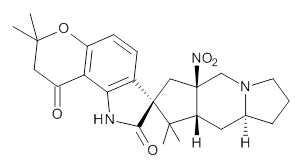I was lucky enough to attend the announcement made in 2012 of the discovery of the Higgs Boson. It consisted of a hour-long talk mostly about statistics, and how the particle physics community can only claim a discovery when their data has achieved a 5σ confidence level. This represents a 1 in 3.5 million probability of the result occurring by chance. I started thinking: how much chemistry is asserted at that level of confidence? Today, I read Steve Bachrach’s post on the structure of Citrinalin B and how “use of Goodman’s DP4 method indicates a 100% probability that the structure of citrinalin B is (the structure below)”. Wow, that is even higher than the physicists. Of course, 100% has been obtained by rounding 99.7 (3σ is 99.73%) or whatever (this is one number that should never be so rounded!).  But there was one aspect of this that I did want to have a confidence level for; the absolute configuration of citrinalin B. Reading the article Steve quotes[cite]10.1038/nature13273[/cite], one sees this aspect is attributed to ref 5[cite]10.1021/jo051499o[/cite], dating from 2005. There the configuration was assigned on the basis of “comparison of the electronic circular dichroism (ECD) spectra for 1 and 2 with those of known spirooxiindole alkaloids“. However, this method can fail[cite]10.1002/chem.201101129[/cite]. Also, one finds “comparison of the vibrational circular dichroism (VCD) spectra of 1 with those of model compounds“[cite]10.1021/jo051499o[/cite]. Nowadays, one would say that there is no need for model compounds, why not measure and compute the VCD of the actual compound? Even a determination using the Flack crystallographic method can occasionally be wrong![cite]10.1021/jo401316a[/cite]. Which leads to asking what typical confidence levels might be for these three techniques, and indeed whether improving instrumentation means that the confidence level gets higher with time. OK, I am going to guess these.
But there was one aspect of this that I did want to have a confidence level for; the absolute configuration of citrinalin B. Reading the article Steve quotes[cite]10.1038/nature13273[/cite], one sees this aspect is attributed to ref 5[cite]10.1021/jo051499o[/cite], dating from 2005. There the configuration was assigned on the basis of “comparison of the electronic circular dichroism (ECD) spectra for 1 and 2 with those of known spirooxiindole alkaloids“. However, this method can fail[cite]10.1002/chem.201101129[/cite]. Also, one finds “comparison of the vibrational circular dichroism (VCD) spectra of 1 with those of model compounds“[cite]10.1021/jo051499o[/cite]. Nowadays, one would say that there is no need for model compounds, why not measure and compute the VCD of the actual compound? Even a determination using the Flack crystallographic method can occasionally be wrong![cite]10.1021/jo401316a[/cite]. Which leads to asking what typical confidence levels might be for these three techniques, and indeed whether improving instrumentation means that the confidence level gets higher with time. OK, I am going to guess these.
- I think the confidence level for assigning absolute configurations on the basis of ECD analogy with other compounds is the lowest of all the methods. Around 1σ or 68.3% (and this mostly from additional information such as the chemical transforms performed from starting materials of known absolute configuration).
- VCD is higher. If performed on the actual compound, I think it can be as high as 2-3σ or 95.5-99.7%. It is difficult to know how much of this certainty is lost by using only model compounds.
- Flack analysis (of anomalous X-ray)[cite]10.1002/chir.20473[/cite] is probably also at 2-3σ; I suggest however that a fair bit of uncertainly not included in the 2-3σ probably arises from analysing a tiny crystal (1 µg) arising from a solution perhaps 10,000 times larger in weight of sample.
- And of course combining the uncertainties from multiple experiments reduces it overall.
I am not casting any doubts on an assigned absolute configuration on which that of citrinalin B is based, as done in 2005. I have no grounds to think it is wrongly assigned. I am merely suggesting that in 2014, one should be able to achieve an even greater confidence level. And do what the physicists do, try to estimate the confidence level attained. I wonder how much chemistry would match the physicists 5σ-confidence level (99.99994%)?
Tags: chemical, Reading, Steve Bachrach, X-ray
Yesterday (11 February, 2016), the announcement of the detection of gravitational waves was made (doi: 10.1103/PhysRevLett.116.061102 ). The significance was > 5.1σ.
It continues to be interesting that in effect no chemistry is ever announced with a siginficance level quoted. I suspect that the synthesis of a new molecule, and its spectroscopy and crystallographic characterisation however must surely be > 5σ?
I noted above data recorded using LIGO revealed a gravitational wave at > 5.1σ significance. I feel I should also note that the data on which this is based is published at doi: 10.7935/K5MW2F23. It is of course entirely appropriate that this open science project should manage its data openly and in (from what I am able to judge) an exemplarly manner. However! I cannot resist but point out that the metadata associated with the LIGO event is not quite so exemplary, see http://data.datacite.org/10.7935/K5MW2F23